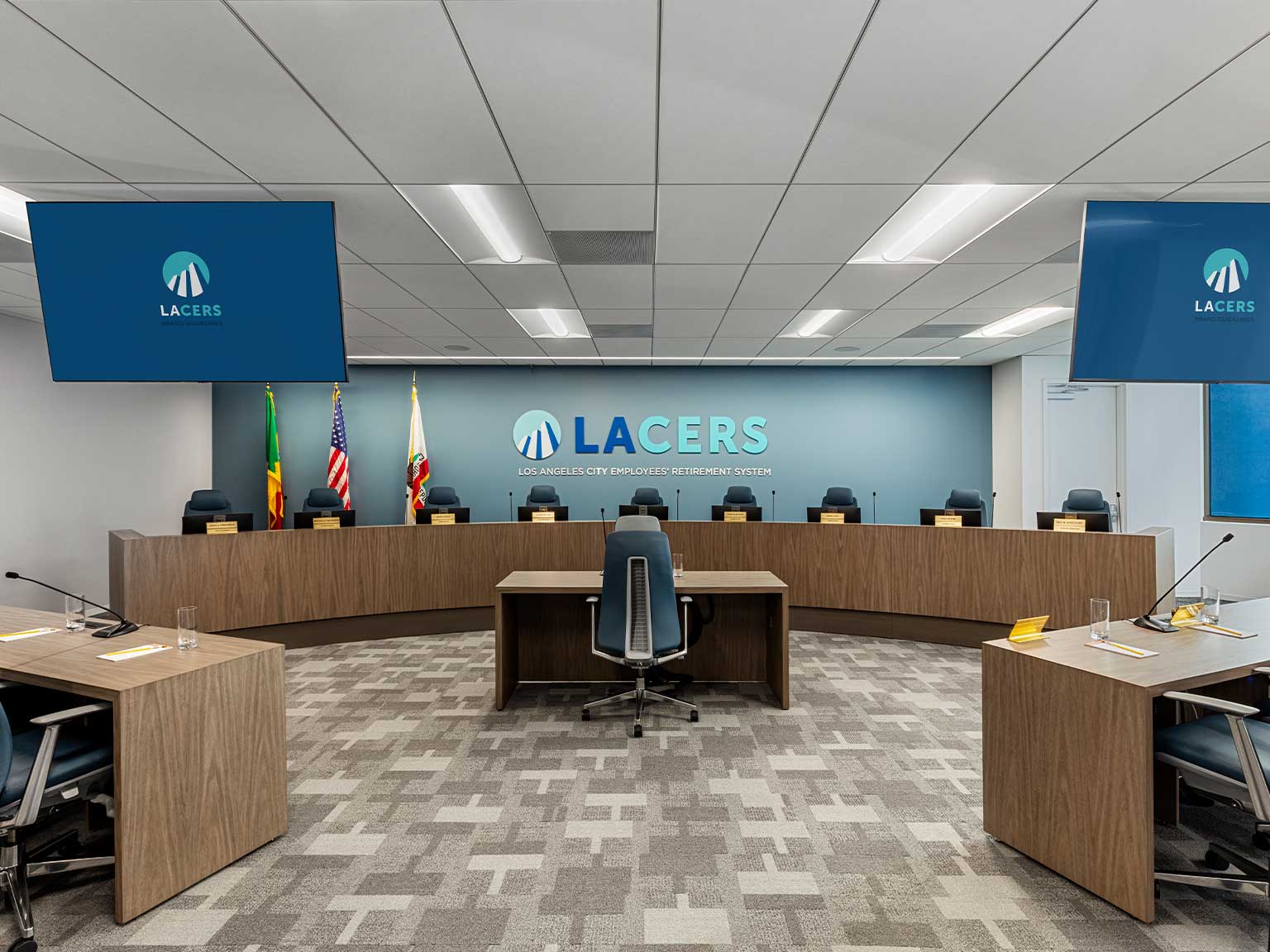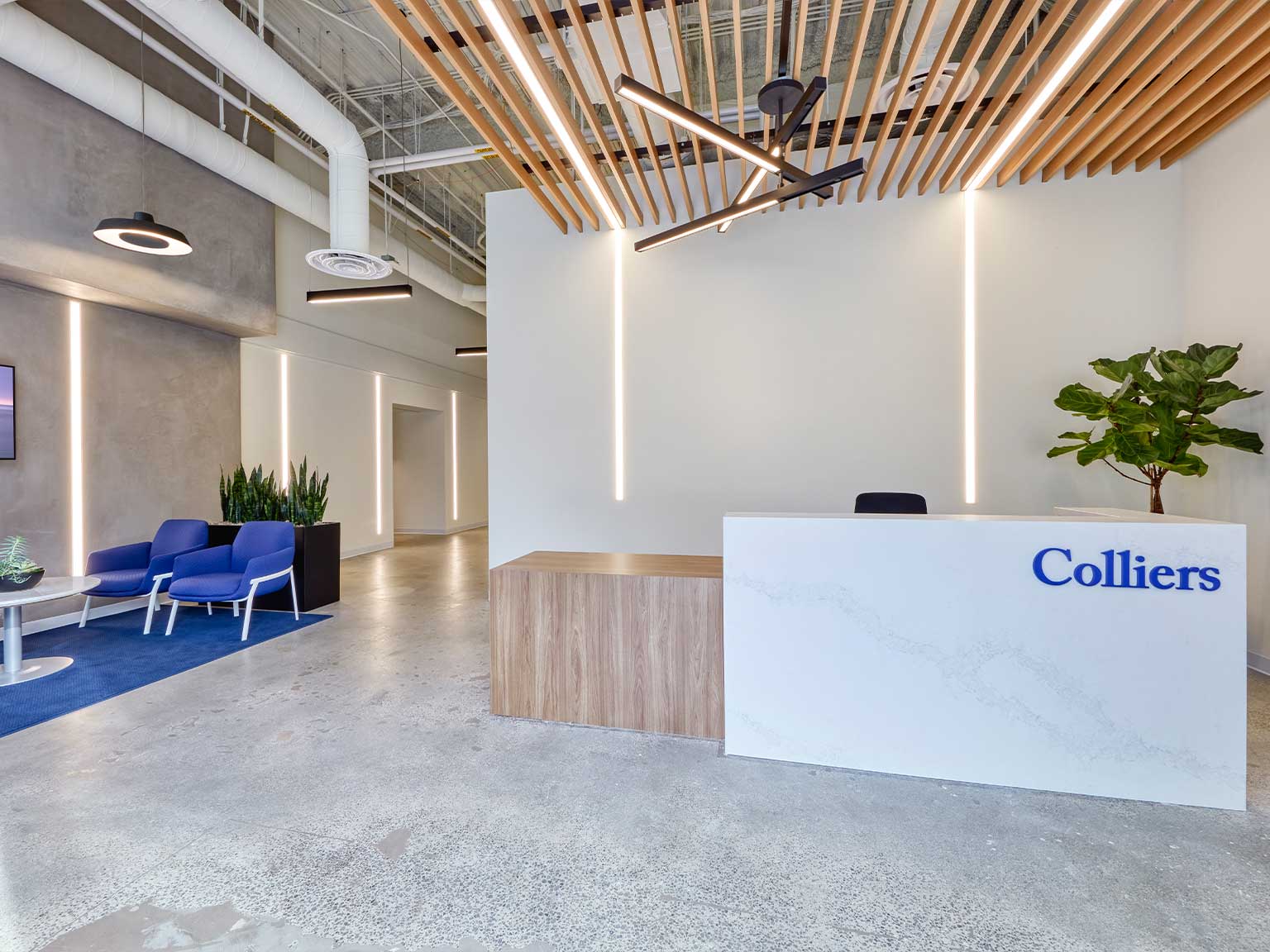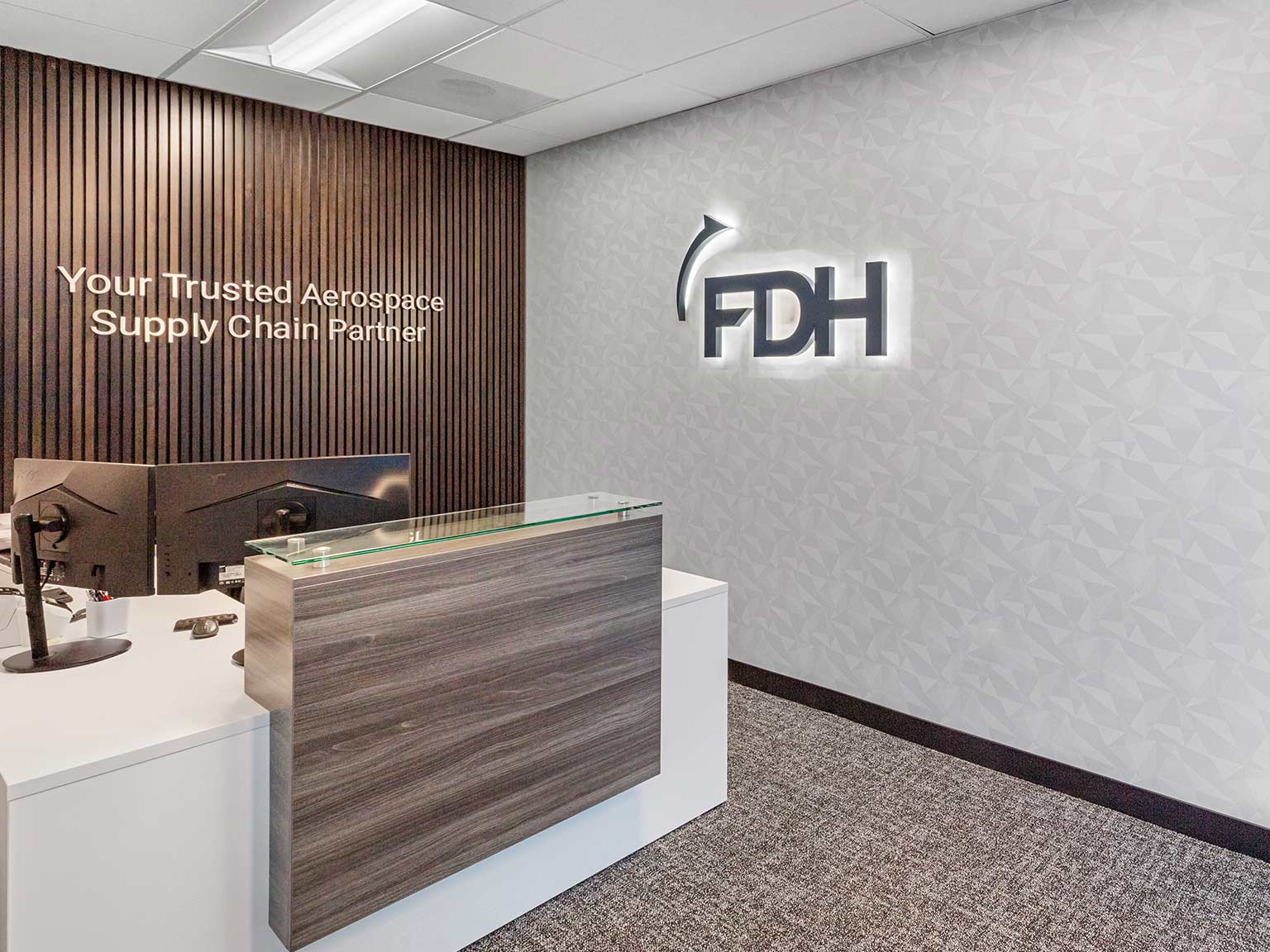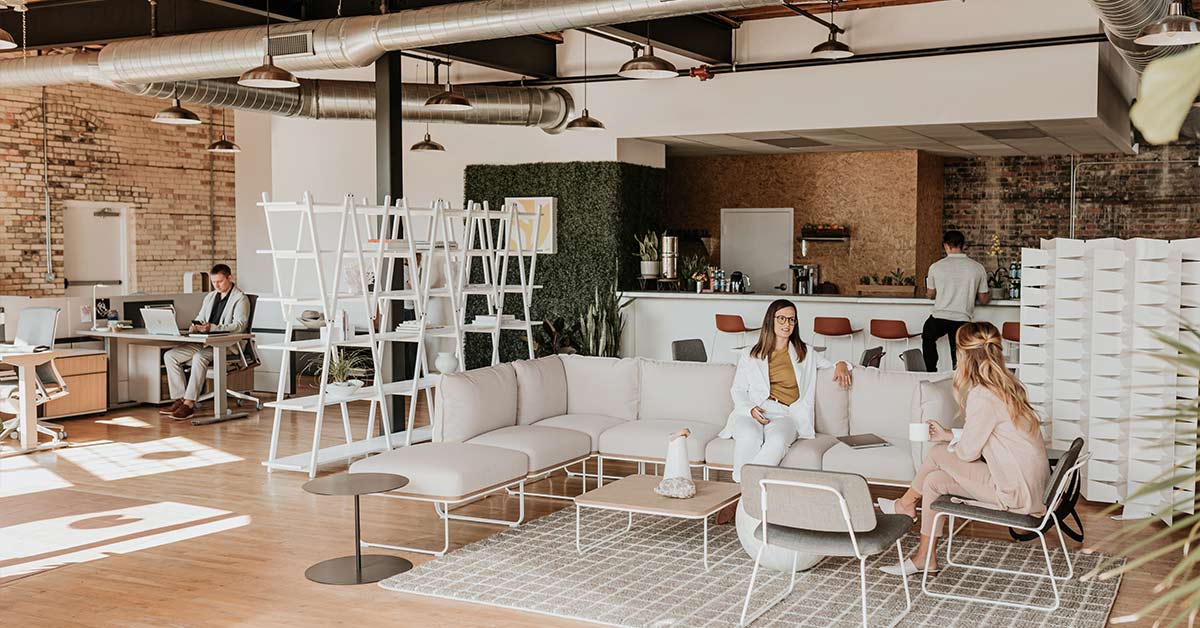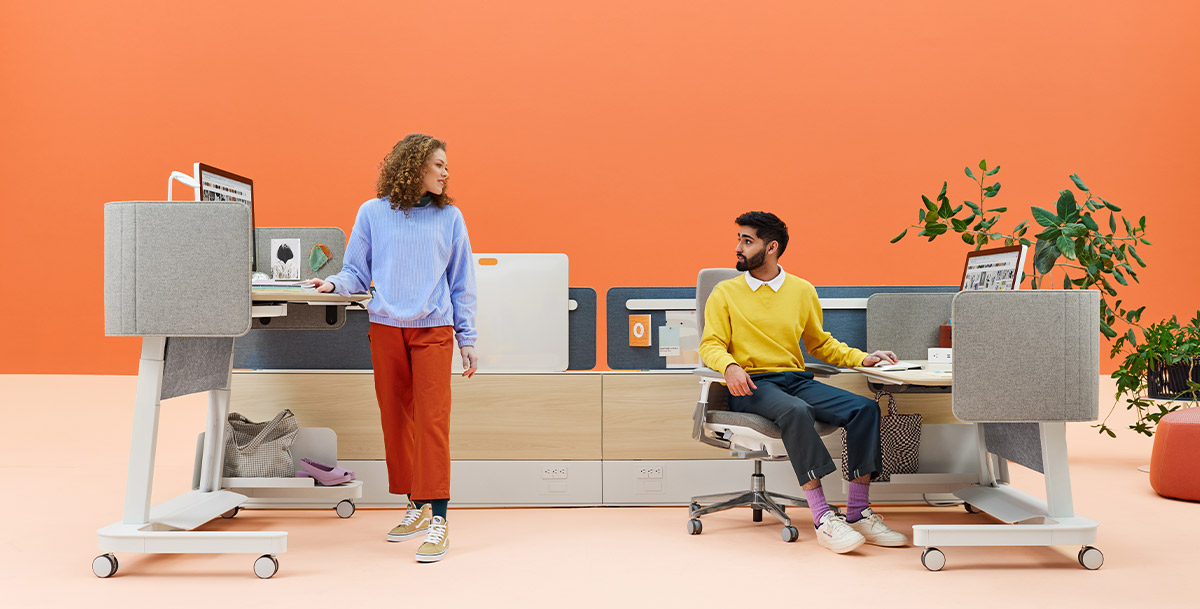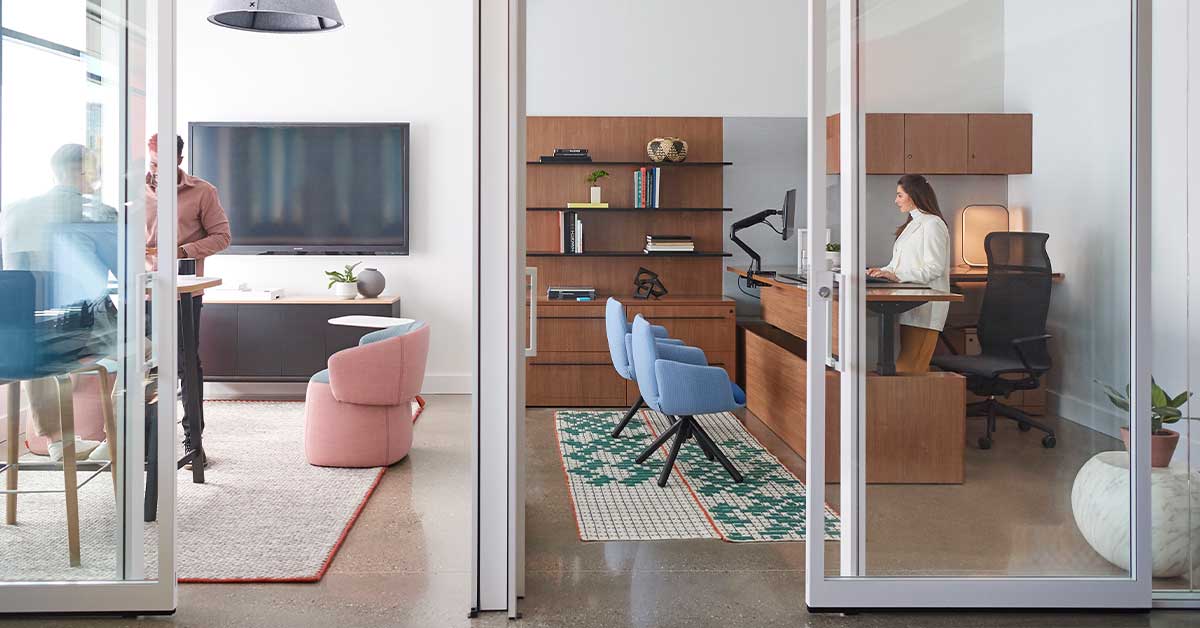Agile Office
What Makes an Agile Office
An agile office is a thoughtfully designed and flexible workspace that offers employees various seating and work style options. Its purpose is to enhance productivity, foster collaboration, and ignite creativity while maintaining flexibility for future reconfigurations.
By combining open floor plan concepts with private areas and smaller social spaces, the agile office caters to the diverse needs of a multigenerational workforce, providing them with a work environment that suits them best.
However, the agile office goes beyond physical design. It also considers the psychological aspects of work, including emotions, thoughts, and behaviors. This approach shifts the focus from a building-centric design to a people-centric one, prioritizing employee health and well-being. The agile office creates a functional space and celebrates aesthetically pleasing environments that engage all senses.
Ultimately, it aims to positively influence behavior, address individual needs, and enhance the way people work while maintaining flexibility for future changes.
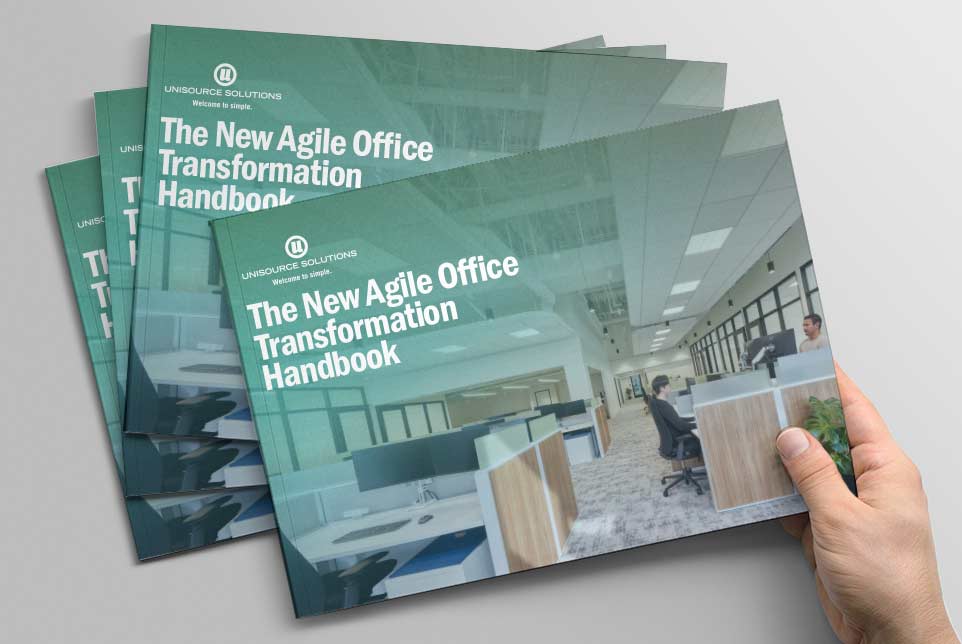
DOWNLOAD
The New Agile Office Transformation Handbook
To help ease your company’s transition into a balanced workplace, we’ve compiled best practices and references to case studies to simplify your process.
Components of an Agile Office
What features make up an agile office? To be a balanced office, the workplace needs to make use of collaborative, community-oriented spaces as well as private areas. Additionally, the agile office needs to lead with a human-centric design, focused on employee physical and psychological wellbeing. It’s not enough for an agile office to function efficiently, it also must perform effectively.
In order to optimize workplace efficacy, the agile office should contain a mix of the these five components:
Open Areas
Designed to increase collaboration and employee interaction, these spaces are the backbone of an agile office design. They offer endless seating options and cater to a multigenerational staff by seating people near each other, regardless of rank, experience or department.
- Open Plan
The open plan concept has been gaining popularity for years. A staple in the tech sector, this floor plan model makes use of large, open spaces, creating one big room where employees complete most of their work. Based on the premise of physically and metaphorically breaking down walls and silos, the open space contains rows of bench seating, minimizing the use of private and enclosed spaces. Employees are seated out in the open, in view of each other, with the ability to talk across desks and easily share ideas and thoughts. An extremely space-efficient design, the open concept allows for more seats per square foot than other office design format, providing companies a cost-savings. Additionally, the open concept provides a sense of egalitarianism, omitting the often rigid hierarchical seating charts of a traditional office floor plan. - Free Address
A subset of the open office is the free address seating plan. As the name implies, employees are free to sit at any unoccupied desk they would like. Based on a first come, first served basis, these non-assigned seats resemble an open office, featuring rows of bench seating or a series of workstations. The underlying concept is the same as the open plan — provide employees with a collaborative work environment that exposes them to different departments and organizational components of a business. Free address allows employees to sit wherever they want, giving them the ability to change their work station daily or weekly. Designed to untether employees from an assigned desk, these work areas offer ample seating to a roving staff, and provide a change in office scenery to legacy employees. One day an employee can be seated amongst his peers, and the next, he can be seated adjacent to a different department head, exposing him to the many levels of a company.
Quiet Zones
- Private Offices
On the opposite end of the open office spectrum is the enclosed private office. These spaces allow for quiet, focused work and are great for discussing sensitive matters, such as financial data or human resource issues. Private offices are oftentimes allotted for executives and due to their physical walls, perimeter the office location. - Office Cubicle
A first cousin of the private office is the cubicle. These partitioned spaces include a workstation and storage unit and often measure 8 feet by 8 feet or 6 feet by 6 feet. While they don’t have permanent walls, they boast partitioned or pony walls that create physical boundaries and provide a sense of privacy. - Workstations
The other first cousin to the private office is the workstation. Essentially, it is a smaller-scaled cubicle that features paneled partitions on three sides of the work surface. They provide enough privacy to hunker down while also communicating an open door policy. - Phone Booths
An offshoot of the private office, these small spaces offer employees a private room to take personal or sensitive business calls. They are touchdown stations that allow employees to get away from their regular desk. As the name indicates, these areas have a small footprint and are designed for one person. They usually consist of a stool and writing surface and can be fully enclosed, allowing for ultimate privacy. - Touchdown Space
This designated area is designed for employees on the go. It provides them a work surface with access to high-speed internet so they can crank out tasks in between meetings. Whether it’s a client visiting the office or a coworker who’s in from out of town, these spaces give the lap-top set a place to touch down while they’re away from their home office.
Meeting Rooms
These enclosed rooms accommodate multiple people and offer a place for planned or impromptu meetings. Designed to bring people together, these rooms are where ideas are shared, partnerships solidified, and new ideas conceived and developed.
- Conference Rooms
Designed to accommodate a large group, conference rooms are essential for in-person meetings, brainstorms and presentations. Equipped with advanced AV systems and / or white boards, they tend to be more traditionally designed, outfitted with long tables surrounded by comfortable task chairs. When outfitted with teleconferencing technology, they are a hub for innovative cross-team and intra-team communication. - Huddle Rooms
The conference room’s younger brother. These smaller-sized meeting rooms are a more casual version of the conference room. Whether designed as two, four or a six person space, these rooms usually feature ancillary furniture, such as plush chairs or sofas, and a brainstorming component, such as a white board or screen that allows for sharing and cross-pollination of ideas. - Breakout Areas
Breakout spaces are a subset of the conference / huddle room, offering a retreat area for small teams. Not quite a room but not quite bench seating, these spaces can be free-standing enclosures centrally located, pod-seating strategically placed, or an area set-up along an exterior wall. They feature ancillary furnishings and / or a communal table for co-working.
Community Centers
The agile office allows for the social aspect of work. These spaces encourage employees to get away from their desks, to ponder over a cup a coffee, or ruminate while grabbing a bite to eat beyond the lunch hour. Furthermore, they encourage impromptu employee interaction and offer a place of respite from intense work and the everyday routine.
- The Pantry
The office pantry is not only an essential kitchen area offering a fridge to keep packed lunches cold and coffee stations to power employees throughout the day, but it is also a social hub. Designed with ample seating and an inviting decor, these water cooler hubs are the center of office sharing. Plus, you can extend the pantry to neighboring areas by installing banquette seating along border walls, further optimizing the use of space. - Lounges
Every employee needs a place to take a break. Whether they are resting their eyes, taking the proverbial smoke break, or huddling with a coworker to decompress, these comfortably laid out break rooms feature sofas and chairs and exude more of a living room vibe than a meeting room set-up. Depending on your office culture, these lounge areas can feature gaming tables such as ping pong or pool, or simply replicate a coffee-shop vibe. - Seating Clusters
The agile office focuses on optimizing use of space. Turning underutilized floor space into comfortable seating areas is an excellent feature of the agile office. Whether you’re arranging a pair of chairs in a tucked away corner or creating a more prominent seating cluster in an unused corridor, these welcoming areas are perfect for socialization and can double as work area.
Utility Rooms
A staple in any office configuration: utility rooms. Utility rooms are the glue that hold an office together. They provide the essentials, allowing facilities to maintain everyday functions.
- Restrooms
Every office has them. Restrooms. They can make a memorable impression or be designed as a utilitarian space. From funky to basic, a well-designed office bathroom is a must. Don’t underestimate their design value. If they can up the resale value of a home and are a selling point for a four-star hotel, so too can they elevate your workpaclv experience. - Office Supply Closet
It’s always good to have a supply closet. From quick-erase markers for the white board or Post-It notes to help you remember what’s due, having the basic office supplies on hand will keep your agile office nimble and your employees prepared. - Resource Library
If you work in a creative field like architecture, you’ll need a resource library to display materials, finishes, catalogues, and fabrics. Dedicating ample space to resources can make the difference of a go-to place or a waste of space. Incorporated as part of the office concept, this area can be central to the design or simply a component. - Print/Copy Stations
Most of us haven’t gone completely digital yet and many of us are not ready to claim that we’re a paper-free office. Some of us still need to print out documents. Dedicate areas for printing and copying and situate them near departments that most often use them.
The Design Element of an Agile Office
The agile office goes beyond the functional layout and dedicated work areas of an office environment. It encompasses the entire look and feel of a space. While the layout sets the framework, the design elements and aesthetics create ambiance and character. In general, a modern-day office takes into consideration a design concept, furniture choice, lighting, and acoustics.
Concept
Once you’ve determined the office framework and how much space will be used as an open plan, private, and communal area, the design concept will further showcase your narrative. Two popular concepts in office design are resimercial and corportality — designing spaces to reflect either a residential space or a hotel property. Another concept gaining traction is biophilia. That is, designing an office to reconnect employees to nature by using passive systems and elements, such as daylighting and natural ventilation, living plants, organic forms, and natural materials. The concept will guide design choices including color and material palette, forms and structures, furniture silhouettes, and lighting choices.
Furniture
After the concept is defined and the backdrop confirmed (colors, materials and circulation), the next step is selecting furniture to bring the narrative to life. Think of furniture in two categories — work stations (desks and chairs) and ancillary furniture (couches and accessory pieces). Your style goal, be it traditional, playful, or modern, will dictate color selection and forms. Furniture is the key to appropriately expressing your design intent.
Lighting
Good lighting is essential for a well-designed office. Lighting is one of the most important elements when designing for ergonomics. Drab lighting that causes eye strain can lower productivity, while good lighting, be it natural daylighting or well-lit spaces, can increase productivity. Additionally, lighting is an important design element. Lounge rooms with ambient lighting can create a warmer, cozier place, more conducive to sharing and intimate knowledge gathering. Reception areas and lobbies that fold in artistic lighting, such as neon-lit backdrops or LED-infused reception desks, can make a statement, helping to emote brand image. When approaching an agile office design project, make lighting an integral part of your strategy.
Acoustics
Sound is just as important as sight. Employees need to focus and time “to hear themselves think”. When designing an agile office consider an acoustic plan to get the most out of your design. Acoustic ceiling panels can absorb overall noise. Wrap-around panels in attractive colors and finishes, not only create a sound barrier at individual work stations, but also add an element of decor. Dropped ceilings, strategically placed, can help muffle sound and create an interesting design element while stylistically defining work areas and guiding you through the space.
The Benefits of an Agile Office
The benefits of the agile office are numerous. This concept delivers unmatched, flexible functionality, designed to optimize space and employee comfort. Agile offices can positively impact how employees feel about their work and improve how they work together. Moreover, it is a platform to express corporate culture and an opportunity to communicate your company’s values and mission to prospective employees and clients.
Optimize Workplace
The agile office gives designers the ability to turn underutilized work areas into flourishing pockets of innovation. By putting the emphasis on quality over quantity of square footage, agile office designers are able to optimize the workplace, putting every square inch to good use.
Increase Employee Satisfaction and Productivity
In this design-driven, health-conscious world, office environments that integrate wellness, aesthetics and mobility, are more likely to improve employee satisfaction, which in turn, can increase productivity. Moreover, by taking a people-centric approach and designing for how an employee best works, can also help with productivity. Like a well-oiled machine, a well-designed office will run more smoothly.
Improved Teamwork
An office design has a big impact on how coworkers engage with each other and share information. Creating spaces to spur communication can pave the path for better teamwork. Having designated areas for teams will inevitably bring them together, giving them ample opportunity to share ideas and brainstorm innovative client solutions.
Convey Corporate Culture
Your office is a living billboard for your brand. It is the foundation of corporate culture as it sets the tone for what your company values. Color, form, seating plans, circulation — all these elements convey your image. When used in harmony with your brand standards, you can successfully tell your company’s story.
Attract, Retain and Appeal to Talent
In order to grab the attention of the best and brightest, companies need to present a place that speaks to their employees. A well-designed office is no longer an office perk; it is the baseline. It is the first introduction of your company culture. If an employee can see themself at your office for eight to ten hours a day, they’re more likely to accept a position. An agile office design gives you an opportunity to appeal to a broad base, offering something for everyone while still staying true to you brand.
Additional Resources
Agile Office Components
THE FUTURE OF THE WORKPLACE: DESIGNING THE EXPERIENCE
Designing for Health: Strategies to Encourage Wellness in the Workplace
Your Company Culture May Be Suffering From Poor Office Design
Five Things You Need to Know About the Changing Office
Bad Mood in the Workplace? Try Changing the Lights
